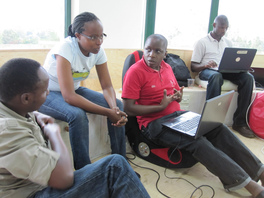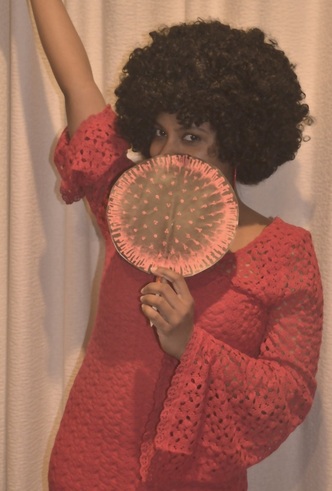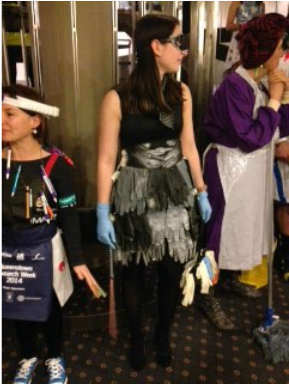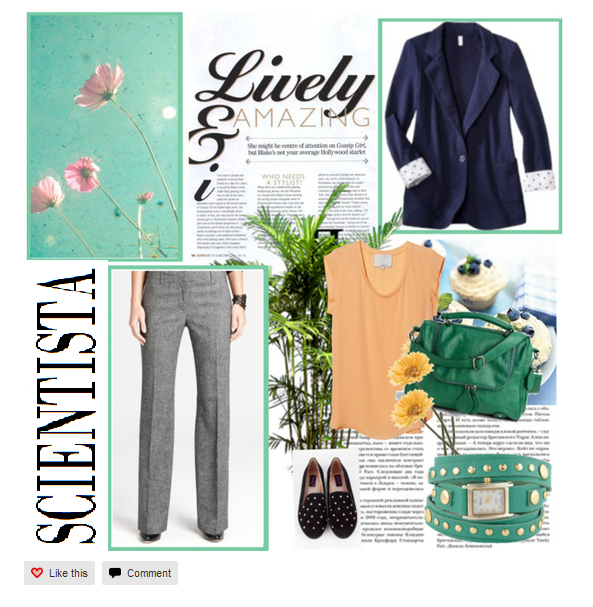Need a (kick-ass) Scientista-esque Halloween costume? We’ve got a few ideas to share…
By Lakshini Mendis
1. The Marionette = grad-student on a string
Inspired by the work done by the movement neuroscience lab, this costume is made out of old participant recruitment posters and electrodes, complete with a TMS-coil-like head accessory! Think it’s time your supervisor frees you too?
Design/model: Jennifer Chin (Fashionomics 2014, Queenstown Research Week)
1. The Marionette = grad-student on a string
Inspired by the work done by the movement neuroscience lab, this costume is made out of old participant recruitment posters and electrodes, complete with a TMS-coil-like head accessory! Think it’s time your supervisor frees you too?
Design/model: Jennifer Chin (Fashionomics 2014, Queenstown Research Week)
2. Gene-pair
Every diploid cell has two copies of the same gene. So, grab your best mate, get garbed in some denim, and you could be a gene-pair too!
Design/model: Frances Sutton (and friend)
Every diploid cell has two copies of the same gene. So, grab your best mate, get garbed in some denim, and you could be a gene-pair too!
Design/model: Frances Sutton (and friend)
3. Pumpkin π
3.14159265359…. anyone?
Design/model: Jacqlin A
3.14159265359…. anyone?
Design/model: Jacqlin A
4. Retro-virus
Idea: Priyesha Mendis
Idea: Priyesha Mendis
5. Fifty Shades of Gloves
It’s time to pay homage to the humble glove - a staple of lab fashion!
Design: Jenny McShane (Fashionomics 2014, Queenstown Research Week, NZ)
It’s time to pay homage to the humble glove - a staple of lab fashion!
Design: Jenny McShane (Fashionomics 2014, Queenstown Research Week, NZ)
WHAT WE ARE READING
Scientistas, looking for a good book? View our March Women's Month suggested reads for women in STEM! We've included recommendations from the Scientista community. Have something to add? Comment below!
SCIENTISTA | WHAT TO WEAR!
Whether it be to lab, to the office, or to lab, always dress to impress in our outfits fit for a Scientista! Find your favorite style below - xx
What's New!
How To Motivate Yourself
|
All Lifestyle Articles
From "Scientist" to "Scientista": The untold story of a transgendered woman in science
|
April 19, 2012
By Kelsey Cruz As scientists, we explore and experiment. We organize and predict. We are intellects and earth shakers, commandeering the why’s and making them what’s. Although we don’t know everything, we trust that every new discovery is just a lab hour away. But what happens when the problem is harder to solve – more difficult than any mathematic formula or radioactive experiment? As a scientist, what do you do when you’re unhappy as yourself, in your own body? You change it, of course. “In the mid nineties, I decided that I could no longer live as a male,” said Amy Prager, graduate student at Columbia University and Princeton University. “I became disgusted with the way males behaved. Males are trained from a very early age to disparage and disrespect women and anything feminine, and I could not live that way anymore.” |
The Struggle of Female Scientists

March 16, 2012
By Janet Nguyen
Women in the field of science are now earning Ph.D.’s at an unprecedented rate and, according to a study funded by the National Science Foundation, also have better chances than their male peers at obtaining tenure-track positions. If only they applied. [1]
Women have made great strides in the field of science, mollifying the public perception that gender inequality in the workforce is an archaic problem of misogynistic institutions past; yet a male dominated culture persists, albeit, often in a discreet manner. This prevents some women from even considering obtaining authority positions within the higher education community or from being satisfied with their positions if they have one. [1]
By Janet Nguyen
Women in the field of science are now earning Ph.D.’s at an unprecedented rate and, according to a study funded by the National Science Foundation, also have better chances than their male peers at obtaining tenure-track positions. If only they applied. [1]
Women have made great strides in the field of science, mollifying the public perception that gender inequality in the workforce is an archaic problem of misogynistic institutions past; yet a male dominated culture persists, albeit, often in a discreet manner. This prevents some women from even considering obtaining authority positions within the higher education community or from being satisfied with their positions if they have one. [1]
Survival Tips for Young Women in Male-Dominated Classes

Are you the only girl in your science class?
November 1, 2011
By Nathalie Miraval
Let’s face it: it can be daunting being one of the few, if not only, girls in a science class which is swimming with boys. Though you may not have faced direct discrimination in your science classes, being one of the only girls can often feel isolating, especially when it comes down to working on problem sets or speaking out in class. But fear not! Here are some tips from Harvard engineering and astrophysics majors, Nan Du, Katerina Mantzavinou, Yara Wehbe, Jackie Quinn, and Mariel Pettee for how to keep your confidence in male dominated classes.
By Nathalie Miraval
Let’s face it: it can be daunting being one of the few, if not only, girls in a science class which is swimming with boys. Though you may not have faced direct discrimination in your science classes, being one of the only girls can often feel isolating, especially when it comes down to working on problem sets or speaking out in class. But fear not! Here are some tips from Harvard engineering and astrophysics majors, Nan Du, Katerina Mantzavinou, Yara Wehbe, Jackie Quinn, and Mariel Pettee for how to keep your confidence in male dominated classes.
How to dress .... for Lab! (Spring Edition)
|
April 18, 2012
By Natalie Punt Deciding what to wear is a question many women face on a daily basis. Deciding what to wear to a new job or internship can be even more challenging. Many people take their dress cues from what others are wearing in their work environment. However, what if the environment you are about to enter is fraught with strict dress codes, strange neck ties and trousers, and little precedent for women? The laboratory setting can be a strange place to dress for, as it is occupied by a broad spectrum of ethnicities, peer expectations and safety codes. In addition, the public perception of “the scientist” often portrays a middle-aged, quirky, unkempt workaholic male. Females entering the laboratory may have a tough time finding a style that is simultaneously compatible with lab members and maintains a unique sense of self. Here are my tips on how to do just that! |
How to Manage Stress
|
April 20, 2012
By Natalie Punt Many of us have a nagging companion… a little sidekick that sticks to us like honey. For those of us in science and technology we call that sidekick, stress. Stress evolved as a physiological response to psychologically perceived harmful situations. It is the mental equivalent of temperature or chemical sensors on the skin that facilitate the withdrawal of your hand from a painful stimulus. Stimuli that cannot invoke a physical stimulus instead send signals to sensory pathways that invoke a self-preservation response. This causes the hypothalamus to activate the sympathetic nervous system. Upon activation the sympathetic nervous system signals the release of epinephrine and norepinephrine from the adrenal medulla, which inhibit digestion, enhance glucose synthesis and increases blood flow to skeletal muscles (Koolhas, 2008). An increase in circulating nutrients provides the energy necessary for escaping a harmful situation or fighting for territory. |
Women in STEM: Past and Present
|
November 12, 2011
By Kelsey Cruz Dr. Billie Blair, organizational psychologist and President/CEO of the international management-consulting firm, Change Strategists, Inc recently spoke with a client, a successful farmer from Virginia. He spoke about having recently entertained guests - a high-profile woman and her family- at his farm. He liked her; she had good family associations and she was pleasant. After spending the day with this smart, successful, prominent woman and her family, the farmer decided he thought her and her family were much like a Friday night football game. As we know, a football game involves coaches, players, quarterbacks, various supporters . . . and cheerleaders. |
The Mismeasure of Woman |
Spring 2011
By Sarah Ballard In a recent psychology study conducted in an undergraduate physics course at the University of Colorado, students were asked to complete a fifteen-minute writing exercise in their first discussion section (2). They were told that the exercise was meant to improve their communication skills. The study instructed them to reflect on the values that are important in their lives: some of the choices were independence, creativity, relationships with family and friends, and sense of humor. The students then wrote a few sentences about why these values mattered in their lives. (Read more.) |
The Scientista Foundation, Inc. All Rights Reserved © 2011-2021 | Based in NY | [email protected]
The Network for Pre-Professional Women in Science and Engineering
The Scientista Foundation is a registered 501(c)(3) -- Donate!
The Network for Pre-Professional Women in Science and Engineering
The Scientista Foundation is a registered 501(c)(3) -- Donate!











